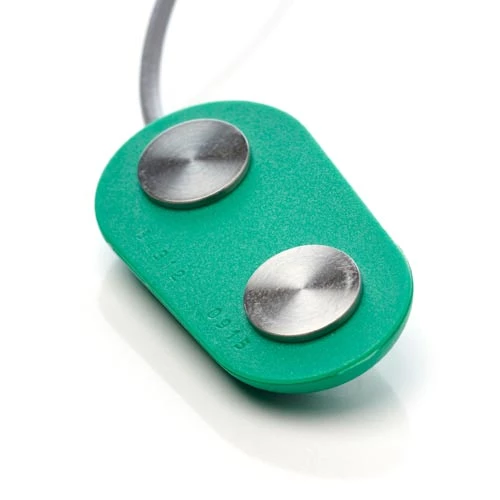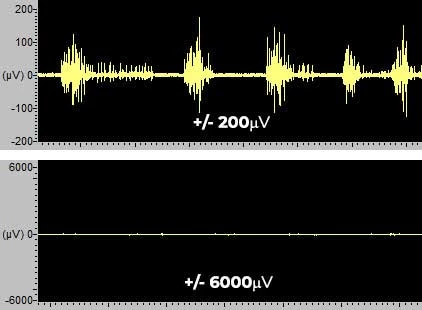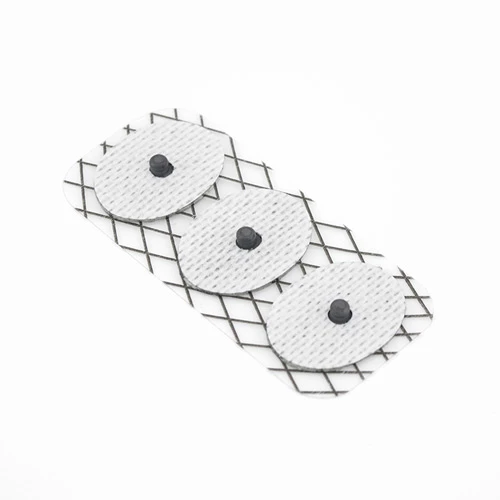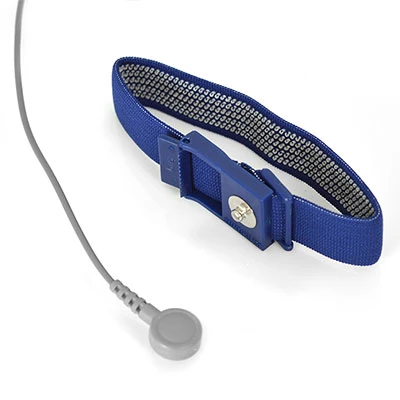EMG Sensors
Biometrics Ltd's advanced EMG sensors are designed with cutting-edge technology, built on years of dedicated research and development. These sensors are tailored to meet the demanding needs of muscle activity analysis in research settings.
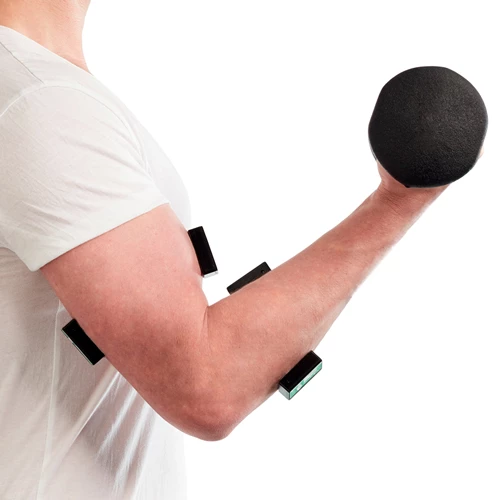
Advanced EMG Sensors for Muscle Analysis
Unlock the power of precise muscle measurement with Biometrics Ltd. EMG sensors, expertly designed for your convenience in both wired and wireless configurations. With input impedance greater than 100 Mohms, our sensors require minimal or even no skin preparation - saving you valuable time in your research and studies.
The DataLITE wireless EMG sensor is small, lightweight and uses progressive frequency hopping, error detection and data recovery algorithms, allowing muscle activity readings to be smooth and robust even in a typical work environment with a range of up to 30 meters from its interface.
EMG Sensor (Wireless / Wired)
| DataLITE Wireless EMG Sensor | Wired EMG Sensor | |
|---|---|---|
| Product Ref | LE230 | SX230 |
| Dimensions | 42 x 24 x 14 mm | 37 x 20 x 6 mm |
| Mass | 17 g | 5 g (excluding cable and plug) |
| Bandwidth | 10 – 250, 470, 950, 5000Hz | 20 – 460Hz |
| Additional Bandwidths | N/A | 5Hz – 480Hz 5Hz – 1000Hz |
| Contact Diameter | 10 mm | |
| Contact Center Spacing | 20 mm | |
| Electrodes | Integral dry reusable | |
| CMRR @ 60 Hz (dB) | > 96 dB (typically 110 dB) | |
| Full Scale | User Select ±6000µV, ±6mV, ±2000µV, ±2mV, ±600µV, ±200µV, ±60µV |
+/- 3 mV Peak to Peak ± 1mV, ±3mV |
| Gain | Standard unit x1000 (100 also available) | |
| Input Impedance | >100 Mohms | |
| Accuracy | +/- 1.5% | +/- 2% full scale |
| Noise | ‹ 5µV | |
| Supply Voltage | N/A | +3.50 to +5.5 Vdc |
| Battery Life | Up to 8 hours | N/A |
| Battery Type | Rechargeable Li-lon Polymer | N/A |
| Wireless Transmission Data Loss | Tolerant for 100 mS | N/A |
| Range from Interface | Wireless range up to 30m | 1.25m cable (custom lengths available on request) |
| Compatible Interfaces | DataLITE PIONEER, ADVANCE, EXPLORE | DataLOG, DataLINK, Amplifier or 3rd party |
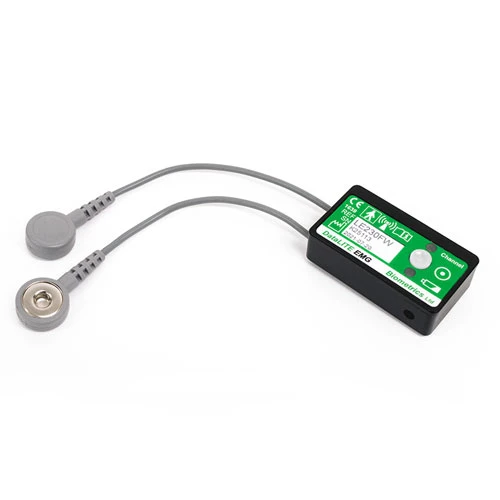
EMG Amplifiers
In areas where adjustable inter-electrode distance is necessary, our wireless LE230FW or wired SX230FW sensors stand out with their flexible design that is compatible with any reusable or disposable SEMG electrode incorporating a 4mm snap. The maximum inter-electrode distance is 170mm and the minimum distance is dependent upon the size of the electrodes used.
EMG Amplifier (Wireless / Wired)
| DataLITE Wireless EMG Amplifier | Wired EMG Amplifier | |
|---|---|---|
| Product Ref | LE230FW | SX230FW |
| Dimensions | 42 x 24 x 14 mm Two 4 mm snap connectors on 100 mm wires |
38 x 20 Two 4 mm snap connectors on 100 mm wires |
| Mass | 17 g (excluding cable and plug) | 8g (excluding cable and plug) |
| Bandwidth | 10 – 250, 470, 950, 5000Hz | 20 – 460Hz |
| Additional Bandwidths | N/A | 5Hz – 480Hz 5Hz – 1000Hz |
| Contact Diameter | Dependant on electrode size | |
| Contact Center Spacing | Variable | |
| Electrodes | Disposable | |
| CMRR @ 60 Hz (dB) | > 96 dB (typically 110 dB) | |
| Full Scale | User Select ±6000µV, ±6mV, ±2000µV, ±2mV, ±600µV, ±200µV, ±60µV |
+/- 3 mV Peak to Peak ± 1mV, ±3mV |
| Gain | Standard unit x1000 (100 also available) | |
| Input Impedance | >100 Mohms | |
| Accuracy | +/- 1.5% | +/- 2% full scale |
| Noise | ‹ 5µV | |
| Supply Voltage | N/A | +3.50 to +5.5 Vdc |
| Battery Life | Up to 8 hours | N/A |
| Battery Type | Rechargeable Li-lon Polymer | N/A |
| Wireless Transmission Data Loss | Tolerant for 100 mS | N/A |
| Range from Interface | Wireless range up to 30m | 1.25m cable (custom lengths available on request) |
| Compatible Interfaces | DataLITE PIONEER, ADVANCE, EXPLORE | DataLOG, DataLINK, Amplifier or 3rd party |
Biometrics Ltd.'s EMG sensors and systems have been frequently used for a myriad of applications, underpinning crucial research and development in ergonomics, sports science, and medical fields.
EMG Consumables
Frequently Asked Questions
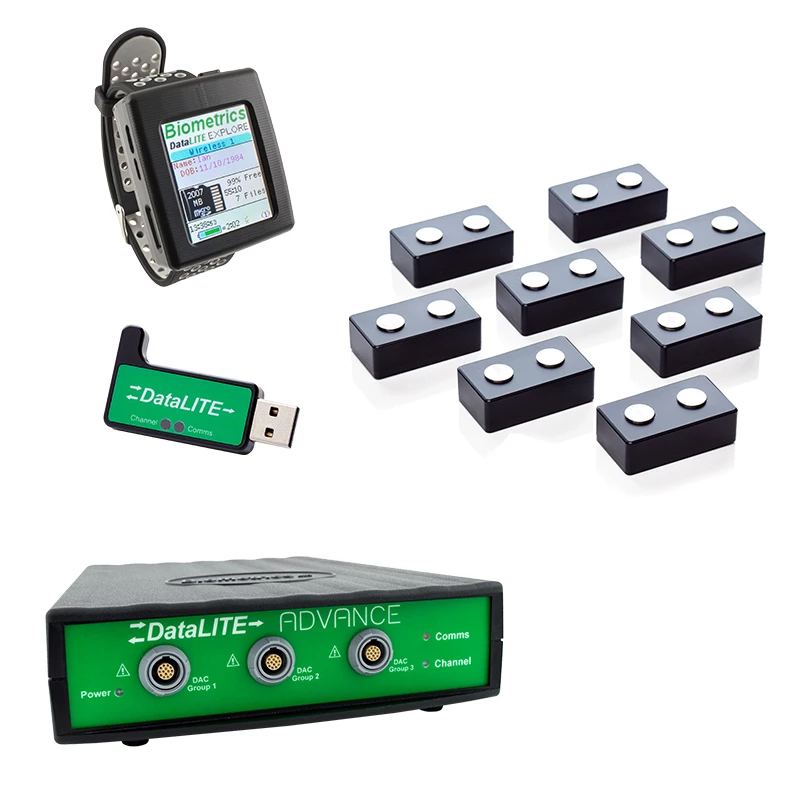
EMG Systems
Technologically advanced yet cost-effective range of wireless, portable, and laboratory EMG data capture systems offering full portability and real-time display and analysis options.
EMG Citations
Here are a few of our favourite studies using Biometrics Ltd EMG sensors
The Effect of Shin-Torso Alignment on Muscle Activity and Joint Angles of the Lower Extremity in Collegiate Ice Hockey Players
Pring, Noah A. et al.
International Journal of Exercise Science: Vol. 14: Iss. 1, Pages 552 - 562
Full body mobile brain-body imaging data during unconstrained locomotion on stairs, ramps, and level ground
Brantley, J., Luu, T., Nakagome, S. et al.
Vibration-Damping technology in tennis racquets: Effects on vibration transfer to the arm, muscle fatigue and tennis performance
I.-L. Yeh et al.


